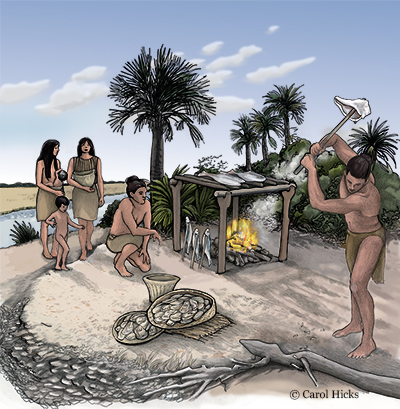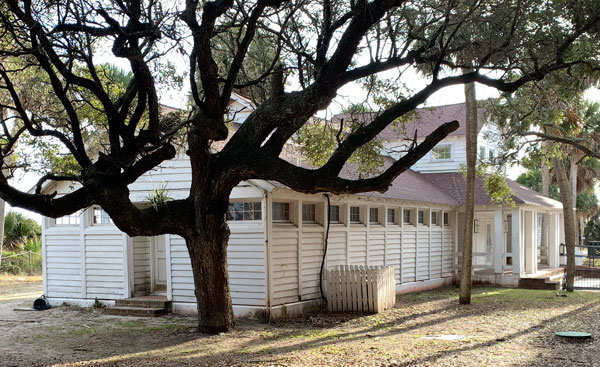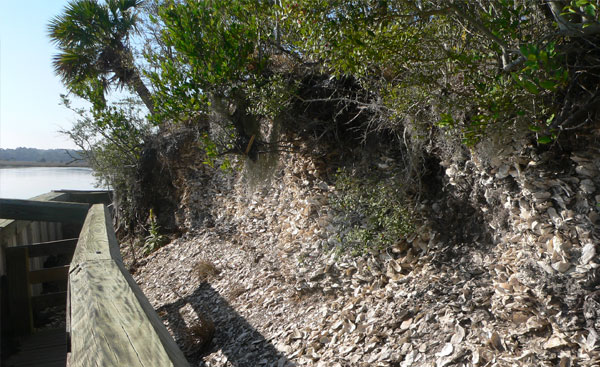Edisto Island: Spanish Mount and Pockoy Shell Rings

Site: Edisto Island, South Carolina
Locations: Edisto Beach State Park, Spanish Mount
Google Maps Link
Date of visit: December 2024
My Trip to Edisto Island
I learned about Edisto Island, South Carolina, when I was commissioned to create an archeological recreation drawing of Fig Island. At the time, I didn't realize there was a shell midden, Spanish Mount, and two more shell rings at Pockoy Island, all on Edisto. The more I visit Earthworks in person, the more I think if there is one, others won't be too far away. I started my visit at Edisto Beach, a quaint-looking beach town, and then went to the state park. After a blustery walk on the beach, the foam from the waves was blowing across the sand. The beach was covered in shells, and I have read that fossils have been found there, too. The tide must have been out because the Spartina, or cordgrass swamp behind the beach, was dry. I was given instructions to Spanish Mount at the State Park Gift Shop. It was late afternoon; the site was a little distance away, and once there, I dashed through oaks and palms. I found the marker and where the site was on Scott Creek. The protective metal rail was still in the water along the bank. I was warned that very little midden was left, and it was true.
About Edisto Island
Edisto Island is called a sea island and is made up of several smaller islands. Once, the coast was 70 miles further east. After the Ice Age, the oceans rose and flooded the plain and its rivers. This created freshwater and saltwater swamps covering at least a quarter of the island's land mass. The barrier island beaches are a later geological addition made from erosion deposits from the ocean. The ocean and hurricanes continue to shape Edisto Island. This coastline is significantly affected by the current rise in sea level; some accounts say 30 feet per year is lost. At times, the barrier island has been one big island; other times, it has been broken into smaller islands, as it is now. There was a rush to carry out an archeological dig on Pockoy Shell Ring I at the Botany Bay Heritage Preserve and Wildlife Management area before it was lost to the ocean. Pockoy I was thought to be the oldest shell ring in South Carolina, dating to approximately 4,300 years ago, and is gone now.

The climate is subtropical, but it was cooler in the past. Before the Europeans arrived, Edisto was densely forested with oak, hickory, and stands of longleaf pine called pine barrens. I was surprised to learn that the majestic live oak trees I saw were only a hundred years old at most. The original live oaks were cut down because they were prized for shipbuilding.
In the archaic period, people harvested oysters, deer, crabs, and other food, which became shell rings and middens. I saw enough shell material in the area that would have been easy to collect and add to earthworks. Most articles I read suggested that it was refuse from meals and feasts. Studies have been conducted on the density of the layers and type of materials to determine whether these were used long-term or occasionally. It has been suggested that the shell rings were settlements, ceremonial centers, or used to store water. Another use could be to mark the territory. There are roughly 60 to 50 shell rings from South Carolina to Florida. Not many are burial sites. There is a race to find more before the rising water claims them. We can assume some sites are already underwater. Although they now look like beachfront property, they were once on high ground along rivers and swamps.
Surprisingly, the South Carolina shell rings are not attributed to one culture. They are listed as belonging to the Archaic, Middle Archaic, and Late Archaic periods. The people the Europeans met in Edisto during colonization were called the Cusabo. Overall, they were not warlike. Some were enslaved, and others were resistant to Christian conversion. By the 1700s, they were gone from the area.

Archeological Discoveries
Archeological digs at Spanish Mount and Pockoy Island found exquisite deer bone pins incised with designs. There is speculation that the designs might have been tribal and handed down for generations. Other finds were pieces of ancient pottery—Stallings Island pottery, an earlier type that used Spanish moss as a temper. Temper adds flexibility and strength to the clay before firing. Also, Thom's Creek pottery helped with radiocarbon dating. Thom's Creek Punctated Pottery is sand-tempered pottery embellished by pressing periwinkle shells into the wet clay. They also found evidence of stone flakes unavailable in the area, which would have come from trade with upland tribes. Visit storymaps.arcgis.com to see examples of bone pins and pottery shards.
Links to more information
- ArcGIS StoryMaps:Finding Pockoy
- Edisto Beach State Park South Carolina Parks
- A short video about excavations of Spanish Mount South Carolina Parks
- Edisto Island Open Land Trust Mission: “To preserve the rural quality of life on Edisto by protecting lands, waterways, scenic vistas, and heritage through conservation and education.”
References
- Spencer, Charles (2008) 1663 To 1860 Edisto Island Wild Eden to Cotton Aristocracy (Hoopla )
ebook Hoopla www.HooplaDigital.com Arcadia Publishing Inc.